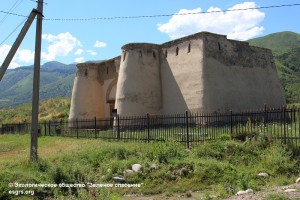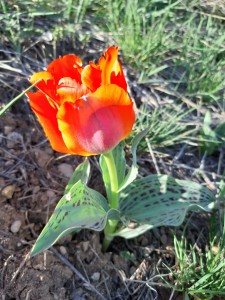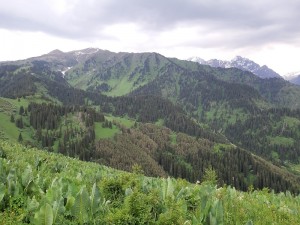… The cultural heritage and the natural heritage
are increasingly threatened with destruction
not only by the traditional causes of decay,
but also by changing social and economic conditions
which aggravate the situation with even more
formidable phenomena of damage or destruction…
Convention concerning the protection
of the world cultural and natural heritage
Thirty years ago, on Friday, April 29, 1994, Kazakhstan became a party to the Convention Concerning the Protection of the World Cultural and Natural Heritage.[1] On Monday, April 29, 2024, no one remembered this.
Neither the Committee of Forestry and Wildlife of the Ministry of Ecology and Natural Resources, which is responsible for specially protected natural areas included in the World Heritage List, nor the Ministry of Culture and Information, which is responsible for cultural heritage. At the briefing of the official representative of the Ministry of Foreign Affairs of Kazakhstan A.S. Smadiyarov, held on April 29, 2024, it was said about the annual weekday meeting of the National Commission of the Republic of Kazakhstan for UNESCO and ISESCO, scheduled for April 30.[2] There is also no mention of this important date in the official material about the commission meeting.[3] The UNESCO Office in Almaty, created in the same 1994, was also silent. In a word, the official bodies celebrated this “anniversary” in silence.
The media also ignored the anniversary. Well, information about World Heritage is not intended for the general reader! Although there is more than enough crime and scandals related to World Heritage sites in Kazakhstan.
Success
What has been done in thirty years?
Six sites are included in the World Heritage List.
In 2003—Mausoleum of Khoja Ahmed Yasawi, cultural heritage.
In 2004—Petroglyphs of the Archaeological Landscape of Tanbaly, cultural heritage.
In 2008—Saryarka-Steppe and Lakes of Northern Kazakhstan, natural heritage.
In 2014—Silk Roads: the Routes Network of Chang’an-Tianshan Corridor, cultural heritage, a transboundary object jointly with China and Kyrgyzstan.
In 2016—Western Tien-Shan, natural heritage, a transboundary object jointly with Kyrgyzstan and Uzbekistan.
In 2023—Cold Winter Deserts of Turan, a natural heritage, a transboundary object jointly with Turkmenistan and Uzbekistan.
On April 30, 2024, during a meeting of the National Commission, the head of the UNESCO regional office in Almaty presented its chairperson with the original certificate of inclusion in the World Heritage List of the Altyn-Emel National Park and the Barsakelmes Nature Reserve—parts of the transboundary object Cold Winter Deserts of Turan.
Six objects. Whether this is a lot or a little, judge for yourself. Tiny Costa Rica has four World Heritage Sites, Kyrgyzstan—three, Finland—seven, Denmark—11, Belgium—16.
It is gratifying that the number of World Heritage sites in Kazakhstan is increasing. However, every year there are more and more fears for their future.
Failures
Altyn-Emel National Park
At the end of 2008, the Kazakhstan Electric Grid Operating Company (KEGOC) Joint Stock Company applied to the World Bank with an application to finance the Moinak Hydroelectric Power Plant Power Delivery Scheme project.
According to the project, the Moinak hydroelectric power station, which was being built on the Charyn River, was planned to be connected to existing electrical networks. The power lines were supposed to be laid through the territories of the Charynsky and Altyn-Emel national parks. The project developers assured that the construction “will not have a negative impact on the flora and fauna.” They were not even embarrassed by the fact that Altyn-Emel was included in the tentative list of sites for nomination to the UNESCO World Heritage List back in 2002!
A concerned public raised the alarm and launched a campaign to protect the national parks. On March 17, 2009, a demand was sent to the World Bank to refuse to finance a project that violates the “World Bank Operational Policy—Natural Habitats” and national legislation. The public demanded that alternative routes be chosen for construction.
In May, an open letter was sent to the president, parliament, the Ministry of Environmental Protection, the Ministry of Agriculture, the Forestry and Hunting Committee, and the Ministry of Energy and Mineral Resources. 85 activists from Kazakhstan, Kyrgyzstan, Russia, Tajikistan, Turkmenistan, and Ukraine signed it. It caused a great resonance.
The World Bank recognized the public’s appeal as justified and suspended financing of the project. The Joint Stock Company agreed that its original version contradicts the requirements of the law “On Specially Protected Natural Areas.” By October, the project was adjusted. The campaign was successful, power lines were erected, but the parks remained intact.
On September 20, 2023, Altyn-Emel National Park was included in the World Heritage List as one of the sites in the Cold Winter Deserts of Turan nomination. More than 20 years have passed since the national park was included in the tentative list of World Heritage!
We would be happy that a new World Natural Heritage site has appeared in the country! If not for one significant “but”! On June 2, 2023, further amendments to legislative acts relating to specially protected natural areas were submitted to the Mazhilis of Parliament for consideration. The essence of the proposals is to expand the possibilities for transferring lands of specially protected natural areas into reserve lands, regardless of whether the norms of international conventions apply to them or not (they were not adopted before June 8, 2024).
In the summer of 2014, the Talgar settlement, which flourished in the 8th-13th centuries AD, was included in the Chang’an-Tianshan Silk Road Corridor Route Network and proudly began to bear the title of a World Heritage Site.
In the fall of the same year, the Chinese delegation, which decided to inspect the facilities located on the territory of Kazakhstan, came to Talgar and was extremely surprised. Markings were made through the Archaeological site for the construction of a road to the Ak-Bulak ski resort. A few meters from the defensive rampart, the construction of a bridge across the Talgar River was already being completed.
A scandal broke out. Construction was stopped, officials promised to do everything according to the law, build a road bypassing the settlement, and ensure the protection of the monument. However, at the beginning of June 2016, construction resumed. A private archaeological firm carried out security excavations, proving that there is nothing valuable here! Moreover, our scientists, the Chinese, from the World Heritage Committee, know nothing about archeology or world heritage! Road workers made a hole through the southern part of the settlement for the highway… However, the scandal became international, so they were unable to complete what they started.
International commissions came twice.
On October 27, 2016, Deputy Prime Minister I. Tasmagambetov held a visiting meeting with representatives of authorized bodies at the site. Construction was completely stopped. The excavation for road construction was filled with soil and sprinkled with straw on top. Information boards were installed and the fence was repaired. However, construction of the bridge was not stopped.
A few days later, on November 8, the site was visited by representatives of the World Heritage Center, the International Council for the Conservation of Monuments and Sites, the Ministry of Culture and Sports, the Ministry of Foreign Affairs (National Commission for UNESCO), the Institute of Archaeology, local authorities, the Passenger Transport Authority and highways of the Almaty region, the public and the media. International experts prepared a “harsh” report, which spoke of violations of the requirements of the World Heritage Convention by government agencies in Kazakhstan.
Only after this, the Talgar Settlement was transferred under the auspices of the State Historical and Cultural Reserve-Museum “Issyk”. The minimum requirements of the World Heritage Center have been gradually fulfilled. A road was built to bypass the monument. The entrance group has been renovated. New information boards were installed and the facility was fenced off on all sides. The entry and exit to the monument territory was completely closed. Grazing of livestock was stopped. The streets in the east and north were paved.
However, the settlement still does not look like a tourist Mecca. Mansions continue to be built in the protected zone. Apparently, officials decided to leave the ill-fated bridge as a monument to the omnipotence of corruption.
In 2016, Sairam-Ugam National Park was included in the World Heritage List as one of the sites in the Western Tien Shan nomination. However, four years later, the “Development Plan for the Hydropower Industry of the Republic of Kazakhstan for 2020-2030” was adopted. According to the plan, it is planned to amend the legislation to allow the seizure of lands of specially protected natural areas for the construction of hydroelectric power stations. The Ugam River is mentioned at number 68 in the plan! That is, violation of the norms of the World Heritage Convention is allowed even at the governmental level.
In 2022, the Correction (feasibility study) of the national park was adjusted in terms of functional zoning and the master plan for infrastructure development. Its necessity was justified, in particular, by “the creation of a cascade of hydroelectric power stations and a water pipeline to provide drinking water to populated areas.” The authors of the Correction did not even remember that Sairam-Ugam National Park is included in the World Heritage List.
The problem, as with Talgar and the Altyn-Emel National Park, has again reached the international level. In 2021 and 2023, the World Heritage Committee included in its decisions certain points regarding the situation in the Sairam-Ugam National Park.[4] The World Heritage Committee has expressed extreme concern about the planned changes to the Sairam-Ugam National Park, as this could “impact the Outstanding Universal Value of the property.” The committee asked Kazakhstan to “provide additional information on this border change at the national level.”
For more than 15 years, the destruction of the natural complexes of the Ile-Alatau National Park, included in the tentative list of sites for nomination to the World Heritage List in 2002, has not stopped.[5]
It will take more than one hundred pages to briefly describe the main problems: illegal construction, transfers of park areas to reserve lands, illegal attempts to create ski resorts, endless adjustments to functional zoning and the general plan, the ecotourism pandemic, litigation on the issue of the park’s protected zone, and so on. The saddest thing is that attempts to grab a tasty morsel from the park do not stop, and they are becoming more and more sophisticated and numerous.
In the last few years, officials and businesspersons have had plans to build a ski resort in the Turgen Canyon. In the Aksai Canyon, on the former territory of the Ile-Alatau National Park, transferred to reserve lands, a mudflow protection dam was built, the feasibility of which raises serious doubts.
“More than 775 million tenge” were stolen during construction.[6] A similar dam was erected in the Big Almaty Canyon for the engineering protection of “national economic facilities located below the designed dam… On the protected territory there are objects of the Almaty hydroelectric power station cascade, the Almaty highway—the Almaarasan sanatorium, and also recreation areas have been built and operate, cafes and restaurants.”![7]
Hundreds of hectares of the national park are leased for long-term and built up with cottages and palaces.
By government decree of May 29, 2020, more than 16 hectares of the Ile-Alatau National Park in the Aksai Canyon were transferred to reserve lands for the construction of a water intake and pipeline. 12,544 trees, including those listed in the Red Book, were cut down! The Canyon has turned into an ordinary industrial zone.
Since last year, the Akimat of Almaty[8] has been laying claim to 20,000 hectares of the Ile-Alatau National Park with the aim of including them in the Medeu regional park. This is not counting the territory of the national park, located within the administrative boundaries of the city, which the Akimat manages as if it were its own backyard!
On March 28, 2024, an announcement appeared on the website of the Charyn National Park about holding public hearings on the project of transferring specially protected areas to reserve lands, including from the Ile-Alatau National Park, for national security needs.
What is next?
November 22, 2023 “Kazakhstan was elected to the UNESCO World Heritage Committee for 2023-2027 based on voting results during the 24-th session of the General Assembly of the States Parties to the Convention for the Protection of the World Cultural and Natural Heritage.” [9] The media immediately reported this. Kazakhstan, together with other participants, will now decide on the inclusion of cultural and natural sites on the World Heritage List assess their state of conservation and plan to provide support to States Parties to the Convention.
We will hypocritically teach others how to preserve the world heritage, and at the local level, we will destroy our own historical and natural monuments!
The country’s specially protected natural areas still do not have the legal status of strategic objects.[10] This makes it easier to manipulate their lands, including those included on the World Heritage List. How then should we understand the term “specially protected”?
The Law “On Specially Protected Natural Areas” still does not contain the category “specially protected natural areas of international importance.” This is one of the tricks that allows officials and businesspersons to arbitrarily interpret not only national legislation, but also ignore the norms of international conventions. Although a similar norm appeared in the law “On the Protection and Use of Historical and Cultural Heritage” back in 1992. Its introduction was connected precisely with Kazakhstan’s intention to join the Convention for the Protection of the World Cultural and Natural Heritage.
The persistent reluctance of legislators to introduce a similar norm into the law “On Specially Protected Natural Areas” raises the suspicion that its absence is beneficial to interested parties!
Despite the fact that there are already 10 nature reserves and 15 national parks in Kazakhstan,[11] the country does not have a special department for the management of specially protected natural areas. All of them are subordinate to the Forestry and Wildlife Committee.
Some departments develop national parks for the development of tourism, others need water, others need river energy, and others need an international image. Their battlefield is specially protected natural areas. Does Kazakhstan really need World Heritage?
If all of these negative trends continue, then in the next thirty years we will lose not only our world heritage, but also vital resources. Poverty and environmental destruction are always interconnected.
© Ecological Society “Green Salvation,” 2024.
________________________________________
[1] World Heritage Convention: https://whc.unesco.org/en/statesparties/kz/.
[2] Briefing by the official representative of the Ministry of Foreign Affairs of Kazakhstan A.S. Smadiyarov, Astana, April 29, 2024, April 29, 2024: https://www.gov.kz/memleket/entities/mfa/press/news/details/761245?lang=ru.
[3] The State Counselor chaired a meeting of the National Commission of Kazakhstan for UNESCO and ISESCO, April 30, 2024: https://akorda.kz/ru/gosudarstvennyy-sovetnik-provel-zasedanie-nacionalnoy-komissii-kazahstana-po-delam-yunesko-i-isesko-3035430.
[4] Decision 44 COM 7B.95: https://whc.unesco.org/en/decisions/7811/; Decision 45 COM 7B.85: https://whc.unesco.org/en/decisions/8263.
[5] World Heritage Convention, Northern Tyan-Shan (Ile-Alatau State National Park): https://whc.unesco.org/en/tentativelists/1681/.
[6] Violations during the construction of the Aksai dam threaten the lives of 30 thousand Almaty residents— Ministry of Emergency Situations, April 12, 2024: https://rus.azattyq.org/a/32902220.html.
[7] Project. Feasibility study for the transfer of lands of the Ile-Alatau State National Natural Park into reserve lands for the construction of mudflow retention structures. TsDZ LLP and GIS “Terra,” Almaty, 2017, p.9.
[8] Akimat—local executive authority.
[9] Kazakhstan elected to the UNESCO World Heritage Committee, November 23, 2023: https://www.gov.kz/memleket/entities/mfa/press/region-news/details/16463?lang=ru.
[10] Civil Code of the Republic of Kazakhstan (General Part), Article 193-1, paragraph 2.
[11] National report on the state of the environment and the use of natural resources of the Republic of Kazakhstan for 2022. Astana, 2023, p.72.
When preparing the material, information from open, publicly available Internet sources was used. All footnotes are current as of July 5, 2024.







